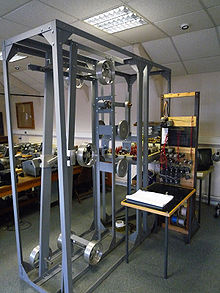Heath Robinson (cryptology)

The Heath Robinson was a cryptanalytic machine that was successfully used by British codebreakers in Bletchley Park (BP), England, to break the German Lorenz key machine during World War II . Improved successor machines were the Old Robinson , the Super Robinson and above all Colossus , the world's first programmable electronic computer .
prehistory
From June 1941, the German Wehrmacht began to secure its telex connections between the highest command posts using a newly developed key machine called Key-Addition 40 (SZ 40). Above the Enigma machine , which is still used for tactical communication, it was used to encrypt strategic communications, in particular between the Wehrmacht High Command (OKW), based in Wünsdorf near Berlin, and the Army High Command (AOK) in cities such as Vienna, Rome, Paris, Athens, Copenhagen, Oslo, Koenigsberg, Riga, Belgrade, Bucharest and Tunis. The British gave him the code name Tunny ("tuna").
After the British codebreaker John Tiltman (1894-1982) had succeeded in laborious two-week manual labor in the fall of 1941, the decisive first break in the SZ 40 and as a result Bill Tutte had completely uncovered the German process, was from July 1, 1942 under the line by Ralph Tester in the so-called Testery der Tunny radio traffic routinely broken by hand.
machine
At the same time, Max Newman sought a machine solution. For this purpose, a machine was designed by Welshman Charles Eryl Wynn-Williams . It served to automate the tedious manual work in the testery . In May 1943 the first copy was completed and ready for use. It was named Heath Robinson with an ironic reference to the then famous cartoonist in the United Kingdom William Heath Robinson (1872-1944), who was known for his comical drawings of machines , the complexity of which was disproportionate to their banal usefulness.
The Heath Robinson proved to be unreliable and was later replaced by the world's first programmable electronic computer , called the Colossus .
literature
- Friedrich L. Bauer : Deciphered Secrets. Methods and maxims of cryptology. 3rd, revised and expanded edition. Springer, Berlin et al. 2000, ISBN 3-540-67931-6 .
- James A. Reeds, Whitfield Diffie , JV Field: Breaking Teleprinter Ciphers at Bletchley Park: An edition of IJ Good , D. Michie and G. Timms: General Report on Tunny with Emphasis on Statistical Methods (1945). Wiley - IEEE Press, 2015. ISBN 978-0-470-46589-9 .
- Bill Tutte : Fish and I . 1998. PDF; 62 kB . Retrieved December 30, 2016.
Web links
- Heath Robinson at the Crypto Museum (English). Retrieved December 30, 2016.
Individual evidence
- ^ Gordon Welchman: The Hut Six Story - Breaking the Enigma Codes . Allen Lane, London 1982; Cleobury Mortimer M&M, Baldwin Shropshire 2000, p. 11. ISBN 0-947712-34-8
- ^ Donald Michie : Colossus and the Breaking of the Wartime "Fish" Codes . Cryptologia , 26: 1, pp. 17-58, 2002. doi: 10.1080 / 0161-110291890740 . DOC; 220 kB .
- ↑ Friedrich L. Bauer: Deciphered secrets. Methods and maxims of cryptology. 3rd, revised and expanded edition. Springer, Berlin et al. 2000, p. 388.
- ↑ Bill Tutte : Fish and I . 1998. PDF; 62 kB . Retrieved December 30, 2016.
- ↑ Friedrich L. Bauer: Deciphered secrets. Methods and maxims of cryptology. 3rd, revised and expanded edition. Springer, Berlin et al. 2000, p. 322.
